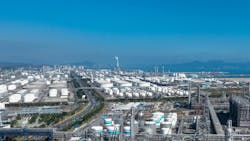Shell-CNOOC JV approves Huizhou Phase 3 ethylene, specialty chemicals expansion
Shell PLC subsidiary Shell Nanhai BV and China National Offshore Oil Corp. (CNOOC) have taken final investment decision (FID) to proceed with the previously proposed third major expansion of ethylene production capacity at the operators’ 50-50 joint venture CNOOC & Shell Petrochemicals Co. Ltd.’s (CSPC) petrochemical complex in Daya Bay Economic & Technological Development Zone, Huizhou City, Guangdong Province, China (OGJ Online, Feb. 27, 2023).
Officially approved as of Jan. 15, CSPC’s Phase 3 expansion will include installation of a third cracker that will add 1.6 million tonnes/year (tpy) of ethylene production capacity to the site’s existing 2.2-million tpy ethylene output, Shell said.
In addition to the new cracker, the expansion will add associated downstream derivatives units for producing other chemicals, including linear alpha olefins (LAO) that are used as feedstock for production of detergent alcohol and synthetic lubricant base oil.
Scheduled for completion in 2028, the Phase 3 project also will involve installation of a new block of units equipped to produce 320,000 tpy combined of polycarbonates and carbonate solvents that, respectively, are used to make impact-resistant plastics and lithium-ion batteries, according to Shell.
While the company has yet to reveal financial details of the project, Huibert Vigeveno—director of Shell’s Downstream, Renewables and Energy Solutions division—said the new investment is consistent with Shell Chemicals & Products strategy to pursue targeted growth at advantaged location, as well as forms a key piece of CSPC’s transformation strategy towards production of more premium and highly differentiated chemical products.
Confirmation of FID on CSPC’s Phase 3 expansion—aimed primarily at meeting China’s domestic demand for chemicals widely used in the agricultural, industrial, construction, healthcare, and consumer goods sectors—follows the operator’s 2023 contract award to Shell Catalyst & Technologies (SC&T) to license selected process technologies for the project.
Alongside licensing of its proprietary production process for styrene monomer and propylene oxide (SMPO) and OMEGA catalytic process for manufacturing of ethylene-oxide-ethylene glycol (EO-EG), SC&T previously confirmed its scope of delivery under the contract also includes licensing of its LAO production technology, as well as supply of associated catalysts for the Phase 3 expansion’s new ethylene cracker.
CSPC Phase 3 expansion details
In a separate Jan. 15 release, CSPC revealed a more-detailed breakdown of specific project components involved in the now-approved Phase 3 expansion.
The overall project will include the addition of 17 main units, including the new cracker as well as 16 sets of downstream chemical production units and supporting installations, according to the operator.
Of the process technologies selected for the project—many of which will be used for the first time in China and the Asia Pacific region—CSPC said SC&T’s proprietary technologies will outfit seven sets of new units capable of providing more than 5 million tpy of chemical products, including metallocene polyethylene, polypropylene, styrene, polyether polyols, EG, alpha olefins, synthetic alcohols, polyalpha olefins, among others.
Also to be outfitted with SC&T-licensed technologies, the polycarbonate portion of the Phase 3 expansion will involve a construction of a 260,000-tpy polycarbonate unit, a 240,000-tpy bisphenol A unit, a 220,000-tpy diphenyl carbonate unit, as well as supporting research and development facilities, all of which are scheduled to be completed by yearend 2026, CSPC said.
With measures undertaken to optimize the project’s overall scope and the planned electrification of large project-related compressor units, CSPC said the Phase 3 expansion, once online, will achieve an overall 20% reduction in carbon dioxide (CO2) emissions, promote the use of renewable green energy and electricity, and help further implement China’s dual-carbon emissions control strategy.
Passed in July 2023 by China’s Central Committee for Comprehensively Deepening Reform (CCCDR), the dual-carbon emissions control strategy called for gradually shifting the country’s focus on reducing energy consumption to reducing carbon emissions as a means of promoting domestic industrial operators’ ongoing transition to renewable-based energy in line with China’s 2060 target for achieving carbon neutrality, according to the CCCDR.
About the Author
Robert Brelsford
Downstream Editor
Robert Brelsford joined Oil & Gas Journal in October 2013 as downstream technology editor after 8 years as a crude oil price and news reporter on spot crude transactions at the US Gulf Coast, West Coast, Canadian, and Latin American markets. He holds a BA (2000) in English from Rice University and an MS (2003) in education and social policy from Northwestern University.

